Abstract
In the search for 1-[(2-hydroxyethoxy)-methyl]-6-(phenylthio)thymine (HEPT) derivatives, we have found several 5-ethyl-6-(phenylthio)uracil analogues to be highly potent and selective inhibitors of human immunodeficiency virus (HIV) type 1. 1-Benzyloxymethyl-5-ethyl-6-phenylthiouracil, the most potent congener of the series, inhibits HIV-1 replication in a variety of cell systems, including peripheral blood lymphocytes, at a concentration of 1.5-7.0 nM, which is lower by a factor of 10(3) than the 50% antivirally effective concentration of the parent compound HEPT. The 5-ethyl-6-(phenylthio)uracil analogues, like HEPT itself, do not inhibit HIV-2 replication but do inhibit replication of 3'-azido-3'-deoxythymidine-resistant mutants of HIV-1. 1-Benzyloxy-methyl-5-ethyl-6-phenylthiouracil and its congeners are targeted at the HIV-1 reverse transcriptase (RT). They do not inhibit HIV-2 RT. They do not need to be metabolized to exert their inhibitory effect on HIV-1 RT. Yet this inhibitory effect is competitive with the natural substrate dTTP. The HEPT derivatives represent a group of RT inhibitors with a unique mode of interaction with HIV-1 RT.
Full text
PDF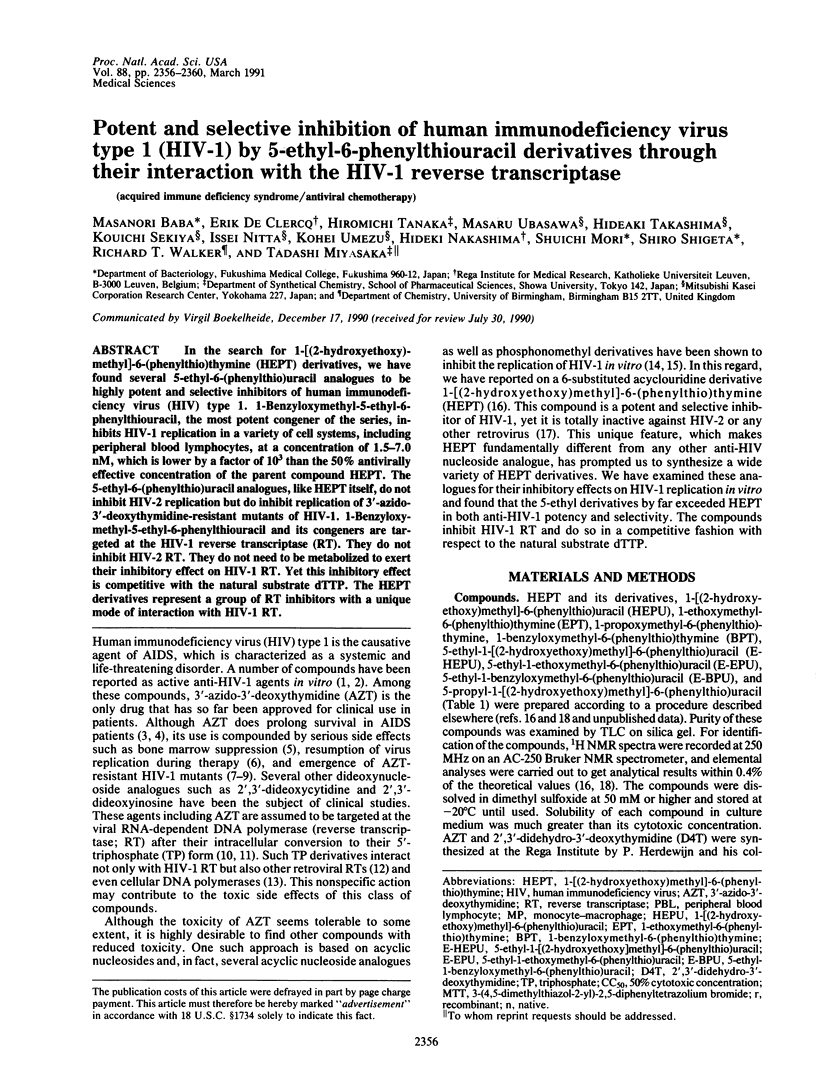
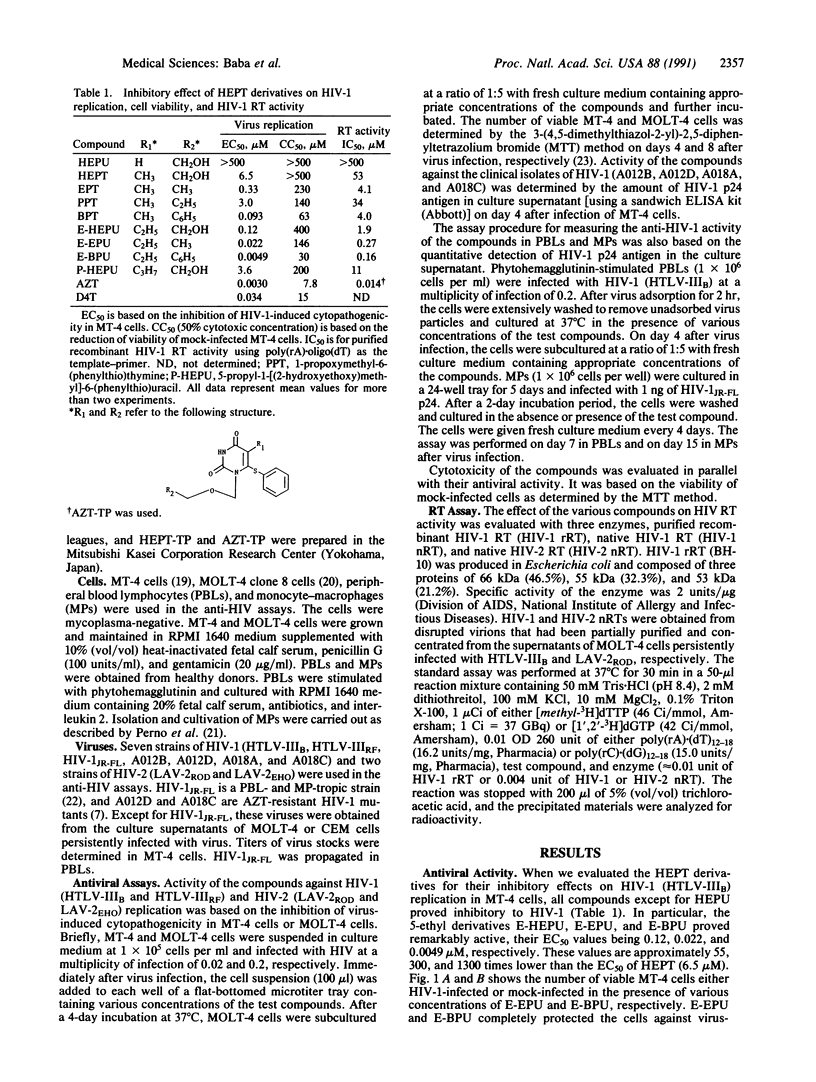
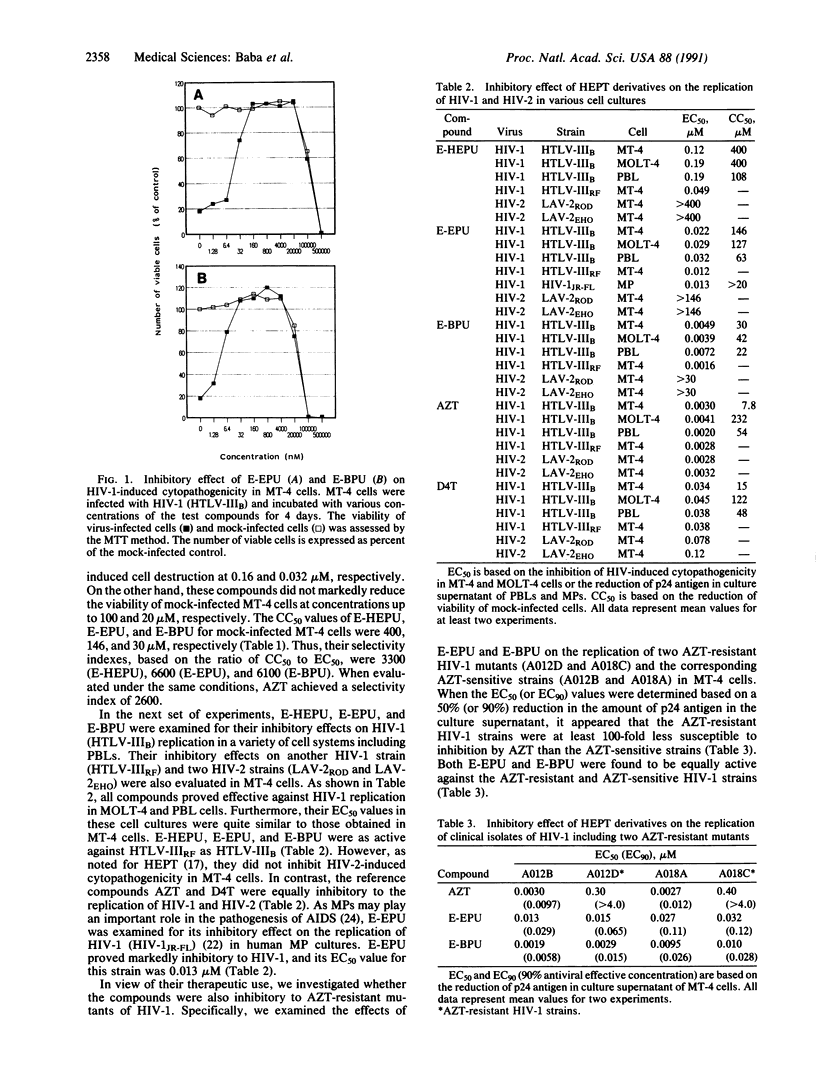
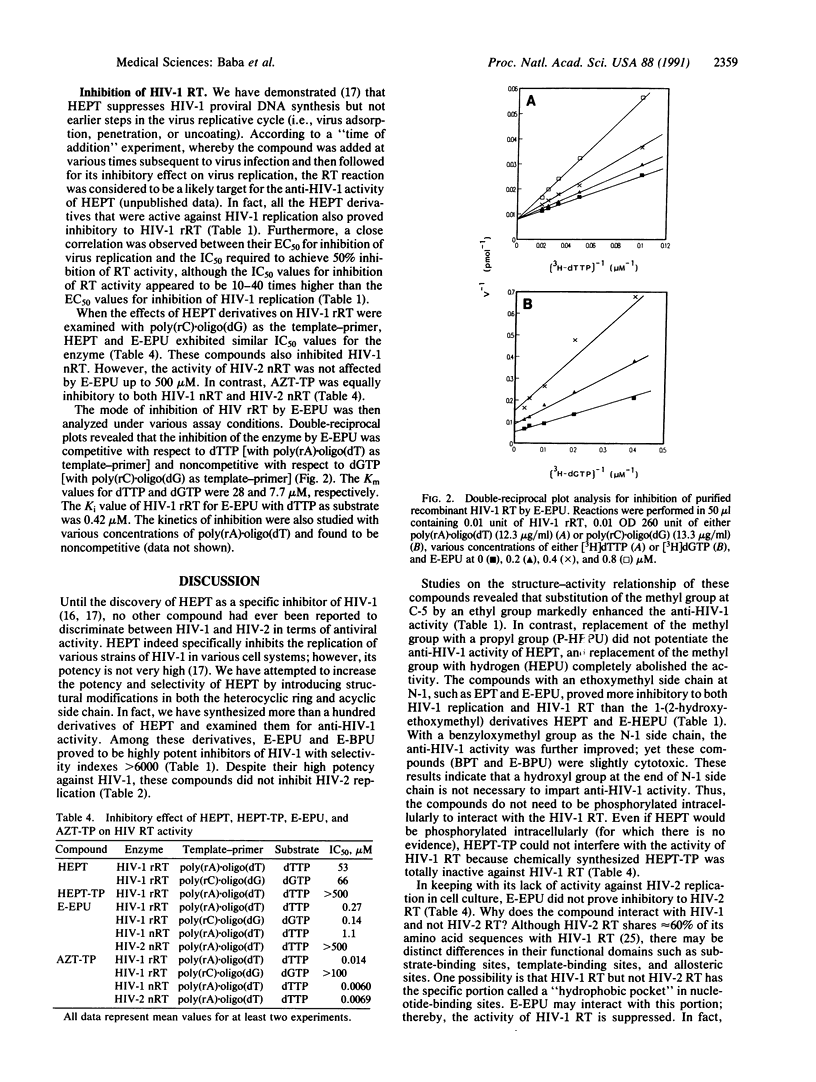
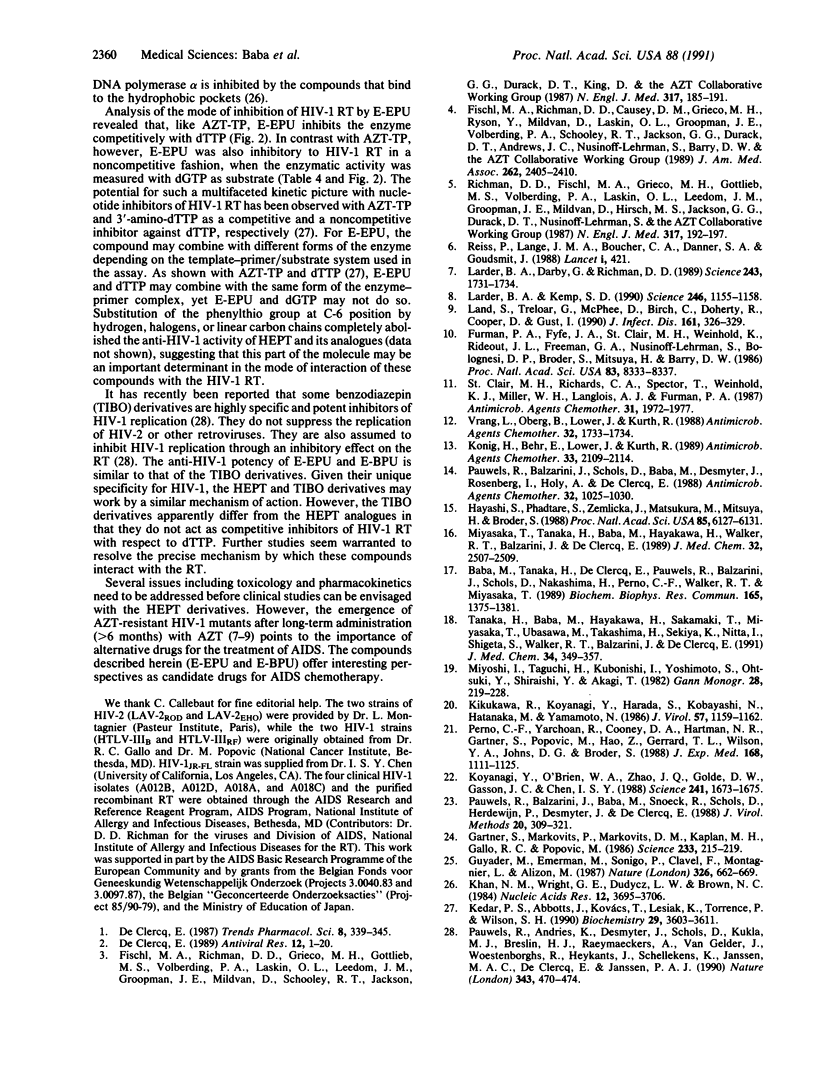
Selected References
These references are in PubMed. This may not be the complete list of references from this article.
- Baba M., Tanaka H., De Clercq E., Pauwels R., Balzarini J., Schols D., Nakashima H., Perno C. F., Walker R. T., Miyasaka T. Highly specific inhibition of human immunodeficiency virus type 1 by a novel 6-substituted acyclouridine derivative. Biochem Biophys Res Commun. 1989 Dec 29;165(3):1375–1381. doi: 10.1016/0006-291x(89)92756-3. [DOI] [PubMed] [Google Scholar]
- De Clercq E. New acquisitions in the development of anti-HIV agents. Antiviral Res. 1989 Aug;12(1):1–19. doi: 10.1016/0166-3542(89)90064-8. [DOI] [PubMed] [Google Scholar]
- Fischl M. A., Richman D. D., Causey D. M., Grieco M. H., Bryson Y., Mildvan D., Laskin O. L., Groopman J. E., Volberding P. A., Schooley R. T. Prolonged zidovudine therapy in patients with AIDS and advanced AIDS-related complex. AZT Collaborative Working Group. JAMA. 1989 Nov 3;262(17):2405–2410. [PubMed] [Google Scholar]
- Furman P. A., Fyfe J. A., St Clair M. H., Weinhold K., Rideout J. L., Freeman G. A., Lehrman S. N., Bolognesi D. P., Broder S., Mitsuya H. Phosphorylation of 3'-azido-3'-deoxythymidine and selective interaction of the 5'-triphosphate with human immunodeficiency virus reverse transcriptase. Proc Natl Acad Sci U S A. 1986 Nov;83(21):8333–8337. doi: 10.1073/pnas.83.21.8333. [DOI] [PMC free article] [PubMed] [Google Scholar]
- Gartner S., Markovits P., Markovitz D. M., Kaplan M. H., Gallo R. C., Popovic M. The role of mononuclear phagocytes in HTLV-III/LAV infection. Science. 1986 Jul 11;233(4760):215–219. doi: 10.1126/science.3014648. [DOI] [PubMed] [Google Scholar]
- Guyader M., Emerman M., Sonigo P., Clavel F., Montagnier L., Alizon M. Genome organization and transactivation of the human immunodeficiency virus type 2. Nature. 1987 Apr 16;326(6114):662–669. doi: 10.1038/326662a0. [DOI] [PubMed] [Google Scholar]
- Hayashi S., Phadtare S., Zemlicka J., Matsukura M., Mitsuya H., Broder S. Adenallene and cytallene: acyclic-nucleoside analogues that inhibit replication and cytopathic effect of human immunodeficiency virus in vitro. Proc Natl Acad Sci U S A. 1988 Aug;85(16):6127–6131. doi: 10.1073/pnas.85.16.6127. [DOI] [PMC free article] [PubMed] [Google Scholar]
- Kedar P. S., Abbotts J., Kovács T., Lesiak K., Torrence P., Wilson S. H. Mechanism of HIV reverse transcriptase: enzyme-primer interaction as revealed through studies of a dNTP analogue, 3'-azido-dTTP. Biochemistry. 1990 Apr 17;29(15):3603–3611. doi: 10.1021/bi00467a003. [DOI] [PubMed] [Google Scholar]
- Khan N. N., Wright G. E., Dudycz L. W., Brown N. C. Butylphenyl dGTP: a selective and potent inhibitor of mammalian DNA polymerase alpha. Nucleic Acids Res. 1984 Apr 25;12(8):3695–3706. doi: 10.1093/nar/12.8.3695. [DOI] [PMC free article] [PubMed] [Google Scholar]
- Kikukawa R., Koyanagi Y., Harada S., Kobayashi N., Hatanaka M., Yamamoto N. Differential susceptibility to the acquired immunodeficiency syndrome retrovirus in cloned cells of human leukemic T-cell line Molt-4. J Virol. 1986 Mar;57(3):1159–1162. doi: 10.1128/jvi.57.3.1159-1162.1986. [DOI] [PMC free article] [PubMed] [Google Scholar]
- Koyanagi Y., O'Brien W. A., Zhao J. Q., Golde D. W., Gasson J. C., Chen I. S. Cytokines alter production of HIV-1 from primary mononuclear phagocytes. Science. 1988 Sep 23;241(4873):1673–1675. doi: 10.1126/science.241.4873.1673. [DOI] [PubMed] [Google Scholar]
- König H., Behr E., Löwer J., Kurth R. Azidothymidine triphosphate is an inhibitor of both human immunodeficiency virus type 1 reverse transcriptase and DNA polymerase gamma. Antimicrob Agents Chemother. 1989 Dec;33(12):2109–2114. doi: 10.1128/aac.33.12.2109. [DOI] [PMC free article] [PubMed] [Google Scholar]
- Land S., Terloar G., McPhee D., Birch C., Doherty R., Cooper D., Gust I. Decreased in vitro susceptibility to zidovudine of HIV isolates obtained from patients with AIDS. J Infect Dis. 1990 Feb;161(2):326–329. doi: 10.1093/infdis/161.2.326. [DOI] [PubMed] [Google Scholar]
- Larder B. A., Darby G., Richman D. D. HIV with reduced sensitivity to zidovudine (AZT) isolated during prolonged therapy. Science. 1989 Mar 31;243(4899):1731–1734. doi: 10.1126/science.2467383. [DOI] [PubMed] [Google Scholar]
- Larder B. A., Kemp S. D. Multiple mutations in HIV-1 reverse transcriptase confer high-level resistance to zidovudine (AZT). Science. 1989 Dec 1;246(4934):1155–1158. doi: 10.1126/science.2479983. [DOI] [PubMed] [Google Scholar]
- Miyasaka T., Tanaka H., Baba M., Hayakawa H., Walker R. T., Balzarini J., De Clercq E. A novel lead for specific anti-HIV-1 agents: 1-[(2-hydroxyethoxy)methyl]-6-(phenylthio)thymine. J Med Chem. 1989 Dec;32(12):2507–2509. doi: 10.1021/jm00132a002. [DOI] [PubMed] [Google Scholar]
- Pauwels R., Andries K., Desmyter J., Schols D., Kukla M. J., Breslin H. J., Raeymaeckers A., Van Gelder J., Woestenborghs R., Heykants J. Potent and selective inhibition of HIV-1 replication in vitro by a novel series of TIBO derivatives. Nature. 1990 Feb 1;343(6257):470–474. doi: 10.1038/343470a0. [DOI] [PubMed] [Google Scholar]
- Pauwels R., Balzarini J., Baba M., Snoeck R., Schols D., Herdewijn P., Desmyter J., De Clercq E. Rapid and automated tetrazolium-based colorimetric assay for the detection of anti-HIV compounds. J Virol Methods. 1988 Aug;20(4):309–321. doi: 10.1016/0166-0934(88)90134-6. [DOI] [PubMed] [Google Scholar]
- Pauwels R., Balzarini J., Schols D., Baba M., Desmyter J., Rosenberg I., Holy A., De Clercq E. Phosphonylmethoxyethyl purine derivatives, a new class of anti-human immunodeficiency virus agents. Antimicrob Agents Chemother. 1988 Jul;32(7):1025–1030. doi: 10.1128/aac.32.7.1025. [DOI] [PMC free article] [PubMed] [Google Scholar]
- Perno C. F., Yarchoan R., Cooney D. A., Hartman N. R., Gartner S., Popovic M., Hao Z., Gerrard T. L., Wilson Y. A., Johns D. G. Inhibition of human immunodeficiency virus (HIV-1/HTLV-IIIBa-L) replication in fresh and cultured human peripheral blood monocytes/macrophages by azidothymidine and related 2',3'-dideoxynucleosides. J Exp Med. 1988 Sep 1;168(3):1111–1125. doi: 10.1084/jem.168.3.1111. [DOI] [PMC free article] [PubMed] [Google Scholar]
- Reiss P., Lange J. M., Boucher C. A., Danner S. A., Goudsmit J. Resumption of HIV antigen production during continuous zidovudine treatment. Lancet. 1988 Feb 20;1(8582):421–421. doi: 10.1016/s0140-6736(88)91219-6. [DOI] [PubMed] [Google Scholar]
- Richman D. D., Fischl M. A., Grieco M. H., Gottlieb M. S., Volberding P. A., Laskin O. L., Leedom J. M., Groopman J. E., Mildvan D., Hirsch M. S. The toxicity of azidothymidine (AZT) in the treatment of patients with AIDS and AIDS-related complex. A double-blind, placebo-controlled trial. N Engl J Med. 1987 Jul 23;317(4):192–197. doi: 10.1056/NEJM198707233170402. [DOI] [PubMed] [Google Scholar]
- St Clair M. H., Richards C. A., Spector T., Weinhold K. J., Miller W. H., Langlois A. J., Furman P. A. 3'-Azido-3'-deoxythymidine triphosphate as an inhibitor and substrate of purified human immunodeficiency virus reverse transcriptase. Antimicrob Agents Chemother. 1987 Dec;31(12):1972–1977. doi: 10.1128/aac.31.12.1972. [DOI] [PMC free article] [PubMed] [Google Scholar]
- Tanaka H., Baba M., Hayakawa H., Sakamaki T., Miyasaka T., Ubasawa M., Takashima H., Sekiya K., Nitta I., Shigeta S. A new class of HIV-1-specific 6-substituted acyclouridine derivatives: synthesis and anti-HIV-1 activity of 5- or 6-substituted analogues of 1-[(2-hydroxyethoxy)methyl]-6-(phenylthio)thymine (HEPT). J Med Chem. 1991 Jan;34(1):349–357. doi: 10.1021/jm00105a055. [DOI] [PubMed] [Google Scholar]
- Vrang L., Oberg B., Löwer J., Kurth R. Reverse transcriptases from human immunodeficiency virus type 1 (HIV-1), HIV-2, and simian immunodeficiency virus (SIVMAC) are susceptible to inhibition by foscarnet and 3'-azido-3'-deoxythymidine triphosphate. Antimicrob Agents Chemother. 1988 Nov;32(11):1733–1734. doi: 10.1128/aac.32.11.1733. [DOI] [PMC free article] [PubMed] [Google Scholar]


